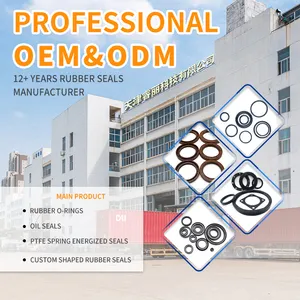
D500cm Water Bottle O-ring Hydraulic Seals Silicone Sealing Ring Colored Rubber Seal O Ring For Concrete Pump Pipe


Kafuka Customized High Temperature Resistant Rubber Seal Ring Waterproof Silicone Rubber Ring Hydraulic Cylinder O-ring























Rubber O rings are essential sealing components used across various industries to prevent the escape of gases and liquids from sealed environments. These rings ensure the secure fastening of components within systems, maintaining the integrity and efficiency of the application they are designed for.
There are several types of rubber o rings, each suited for specific applications. Static O rings are designed to seal interfaces that do not experience movement, while dynamic O rings are engineered to accommodate motion within the seal, such as in pistons and cylinders. The application of these seals spans across numerous sectors, including automotive, aerospace, and manufacturing, where they are critical in maintaining system performance.
The material composition of O rings is crucial for their functionality. NBR 70 and nitrile rubber o rings are popular due to their resistance to oils and fuels, making them suitable for automotive applications. Silicone o rings offer excellent high and low-temperature capabilities, whereas FFKM perfluoroelastomer rings provide high chemical resistance, vital for harsh chemical environments. The choice of material affects the O ring's resilience to pressure, temperature, and chemical exposure.
The advantages of using rubber o rings are numerous. They are known for their durability and ability to withstand high pressures, which is why they are often used in conjunction with o ring screwfix mechanisms for enhanced sealing performance. Their compatibility with other seals, such as nbr ring and hydrogenated nitrile o ring, allows for a versatile use in various dynamic and static applications. Additionally, their simple design facilitates easy installation and maintenance.
Selecting the right O ring involves considering factors such as pressure changes, load, alignment, vibration, and temperature. For instance, an o rubber ring must be chosen with the right material and size to ensure it does not deform under the sealed fluid's pressure. Similarly, the environmental conditions and potential heating from seal operation must be taken into account to select an O ring that can maintain its integrity over time.
In conclusion, rubber O rings are a pivotal component in countless applications, providing a reliable seal against leaks and contamination. With a variety of materials like NBR, silicone, and FFKM, these seals offer flexibility and durability for a wide range of industrial needs. When selecting an O ring, it is essential to consider the specific requirements of the application to ensure optimal performance and longevity.